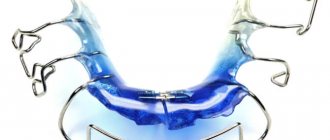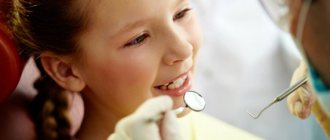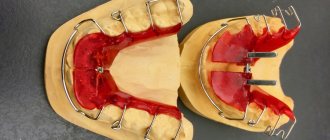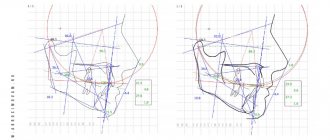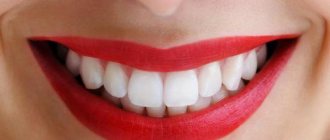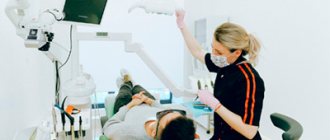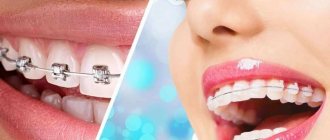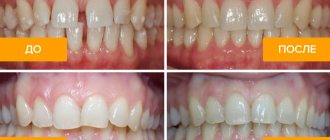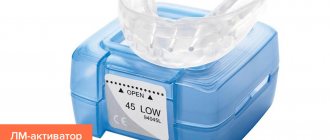Plates for teeth: removable and non-removable
In dentistry, doctors work with different types of orthodontic products. At the initial appointment, the orthodontist will tell the young patient and his parents what the plates for straightening teeth are called, how they differ and what they are like. The most popular:
- systems – single-jawed, with a retraction arch, with a pusher, with a hand-shaped process;
- devices – Brückle, Frenkel;
- Andresen-Goipl activator.
Products are divided according to the method of fixation:
- removable – hypoallergenic polymer construction includes wire hooks and arcs for fixing the plate;
- non-removable – they look like metal brackets that put pressure on the teeth from the outside, forming the correct bite.
A removable dental plate is placed on children to correct simple bite defects. The optimal age of a child for correction is 5-12 years. Fixed products can compete in effectiveness with braces; they are usually recommended for teenagers to eliminate serious anomalies of the dentition.
Braces are non-removable orthodontic structures in which a plate is placed on each tooth, and an arch with a “memory effect” is responsible for correcting the bite. Metal braces are the most effective, but sapphire and ceramic braces are almost invisible on the teeth. There are also ligature braces with rubber bands and self-ligating ones, which reduce the treatment period by several months.
Advantages and disadvantages of circuit plates
Advantages
— Ability to remove the plates, for example, for eating or brushing teeth; — There is no need to stay in the clinic for a long time. Taking an impression for production does not take much time, and the production itself takes place in the laboratory and does not require the presence of the patient; — Efficiency and possibility of their use at an early age in children; — Quite affordable cost compared to other types of treatment.
Flaws
— Parents need to constantly ensure that the child puts on and does not remove the plates on their own.
— Low effectiveness in adolescence (after 12 years); — It is impossible to correct very severe curvatures. The use of braces may be necessary; — The record may break or the child may simply lose it. Perhaps the biggest disadvantage of dental plates is their inability to move teeth. The plates can maintain the correct position, but with severe curvatures, the use of braces may be required. In childhood, for minor curvatures and as a preventive measure, plates are an excellent treatment option.
Does a plate straighten teeth: indications
Children are prescribed plates for the lower teeth and expansion plates for the upper and lower teeth only after a thorough diagnosis. Based on X-ray and panoramic photographs, measurements and study of proportions, the orthodontist decides to place a plate on the child’s teeth.
Treatment is indicated for:
- minor and serious anomalies of dental bite;
- violation of the tone of individual muscles;
- pathologies of tooth growth in the upper or lower jaws;
- incorrect position of incisors and canines;
- disproportionate growth and development of the dentofacial rows.
Orthodontic removable appliances equalize the growth rate of the jaw bones, straighten teeth in given planes, and correct the closure of the jaws.
Children's aligners "Flexics"
“Flexics” is an innovative development for the treatment of children aged 6 to 11 years. Many parents ask me during consultations, is it possible to straighten a child’s teeth without plates? Thanks to this it became real! In 2022, aligners (transparent aligners) for children were created, which were called “Flexics”. Unlike plates, treatment with aligners has a number of advantages:
- the ability to move teeth in all planes;
- no violation of diction;
- convenience and maximum aesthetics;
- absence of allergic reactions and metal elements;
- good fixation.
The treatment technology allows you to straighten the child’s teeth that have already erupted and promotes the proper growth of permanent teeth. “Flexics” are manufactured using computer virtual 3D modeling, which provides greater accuracy and visualization of the process of teeth movement. You need to wear Flexics constantly: both day and night, taking it off only when eating and brushing your teeth.
What do children's dental plates look like?
A plate made in a pediatric dental laboratory is a standard of aesthetic perfection. Any shades, gradient colors, sparkles and bright decorations inside translucent plastic - children are delighted when they see it for the first time.
Structurally, the plate is:
- the base is strong and quite rigid;
- elastic wire - fasteners, arches and hooks are made from it, and it is this wire that provides the necessary pressure to correct the bite;
- the screw is an activator responsible for pressure and intensity of impact.
The screw is tightened by the doctor with a special key, or this is done by the parents according to the correction plan drawn up.
Soldatenkova Alina
I am often asked how dental plaques are made for children. First, we take impressions of the teeth – it doesn’t hurt, but sometimes it’s a little unpleasant. Then, based on the impressions, the appliance prescribed by the orthodontist is manufactured in a dental laboratory. Then try it on and create a design that is comfortable to wear. And issuing a plate to the patient with recommendations for wearing
Bite correction
Most often, leveling plates are prescribed to children to correct temporary (baby) or permanent bites. This treatment is completely justified: the bite can be easily corrected on children’s fragile teeth using a simple design.
When installing a plate to correct a bite, parents must regularly show their child to the dentist. If the pressure on the teeth is too strong, there is a risk of losing a fragile tooth. Therefore, it is important to entrust this work to an experienced orthodontist.
Contraindications
Removable and non-removable leveling plates are not used in a number of cases:
- The child suffers from periodontitis (white spots);
- There is untreated caries on the teeth;
- The child was diagnosed with an allergy to the materials of the device;
- The child suffers from respiratory diseases.
How to install the plate
Installing a plate to straighten children's teeth is a simple, painless procedure. A child does not need to worry when going to the dentist, and parents do not need to be nervous at all.
- First, the doctor takes a panoramic photograph of the teeth (X-ray) - this photograph is needed to determine possible inflammation and abnormalities in the structure of the teeth. Based on the image, the doctor prescribes the optimal design (removable or non-removable).
- The dentist then creates an impression of the jaw. This unpleasant, but absolutely painless procedure is needed in order to make an individual plate that will solve the child’s problem.
- When caries or tartar is detected, dental treatment or oral sanitation is carried out first.
- A plate is installed in the dental laboratory that follows the relief of the palate. It is important to make a structure that will fit tightly to the dentition.
For the first time, the doctor independently places the plate on the child’s teeth, attaches the sharpening, adjusts the structure and gives recommendations for care.
The fixed plate is installed a little longer than the removable one: first, sharpening points are attached to the teeth, into which the arch is then threaded. At first, the child feels slight discomfort from the presence of the plate, but all awkward sensations quickly disappear.
Care
Dental plates are made from unpretentious hardened metal and elastic plastic. Improper care of the device or lack thereof can cause premature failure of the plate.
In order for the staples to serve the required period, children and parents should:
- Clean the plate at least once a day with a soft toothbrush;
- Treat the staples weekly with a disinfectant solution, or better yet, place them in the solution overnight.
- Remove the plate before each meal.
- Rinse the staples with warm boiled water before each installation.
- Store the plate in a special container.
If the plate is broken, you should not repair it yourself. It is better to take the device to a doctor.
How to wear dental plates - recommendations for children and parents
Whether dental plates help is the main concern of parents. Much depends on how correctly the young patient wears the orthodontic apparatus.
The main requirements for wearing orthodontic plates:
- duration – up to 20-22 hours daily;
- care - morning and evening cleansing with pastes, gels, weekly deep cleansing in a special solution;
- remove the product when eating;
- Do not play with the orthodontic appliance - remove it and return it to its place in the mouth with your tongue.
The doctor will show you how to put the plate on your teeth at your appointment, but there is nothing complicated about it. Metal arches fix the structure, and the regulatory elements are responsible for gentle correction of the bite while wearing.
It happens that a child takes the product out of his mouth, and then cannot figure out how to put the plate on his teeth - it either falls off or does not fit into place. Such a circumstance may be preceded by the following events:
- the device was in the mouth for less than 12-14 hours a day, and the fixation was broken;
- supporting units have been removed or fallen out – the structure requires orthodontic correction;
- a tooth erupts under the polymer part of the system and prevents it from taking the correct position;
- the plate was not worn for several days in a row - the bite has returned to its original position and you need to see a doctor to adjust the device;
- violation of medical recommendations for wearing removable plates - it is worth coming to an appointment and checking the condition of the product.
How do plates and braces help get rid of malocclusion?
The plate is created from plastic. Accordingly, it cannot significantly affect a teenager’s bite. It cannot be used if the teenager has serious problems with teeth (crookedness).
Plates are recommended to be used only if the teenager does not have any special problems with his teeth. And if he has minor ailments associated with malocclusion. That is, they are at the first, safest stage.
Also, plates can be prescribed for those teenagers who have had braces on for a certain amount of time. The teeth were cured. And now they want to consolidate the result. Make sure your teeth remain straight. And they did not return to the original position that was before treatment.
Plate installation rules
The plate can be installed in the following cases:
- A teenager's teeth are straight. However, there is a chance that over time they will begin to shift.
- The teeth gradually shift. However, this process began only recently. And it didn't cause any noticeable damage.
- A teenager has problems with the palate. And its width.
The plates are recommended for use if only minor anomalies are detected in a teenager. Which are associated with the jaw and teeth. Braces are recommended for use in the presence of larger bite problems. They are constantly in the teenager's mouth. Due to this, they put pressure on the teeth. And they bend them to the dimensions that the doctor needs to treat the curvature.
Until what age can teeth be straightened with a plate?
Until what age do plates be placed on teeth is a question to be decided on an individual basis. Some devices work best during the period of active changes in occlusion, so they are recommended to be worn until 10-11 years of age. Other products perform well until the teeth completely change - up to 12-14 years. But the doctor assesses the situation more fully.
Often, orthodontists use a combined treatment method - changing devices, selecting new ones for the current situation. That is why it is not always necessary to delve into the names of plates for straightening teeth. The result is important, not what the dental plates are called.
It is difficult to answer how long a plate is worn on the teeth. Some patients require full-time braces and additional treatment with braces at age 14. For others, the situation improves in 1-2 years.
During an orthodontic consultation at Aza&Buka, patients will receive complete information about the treatment. The doctor will not just show a photo of an orthodontic children’s dental plate, but will also conduct an initial diagnosis, tell you the features of the planned correction, the approximate duration of treatment, and prospects. While the adults are talking, children can get acquainted with the variety of orthodontic devices - choose the color of the plate for the teeth and the design.
At what age can you wear plates and braces?
Plate
It is recommended to wear the plate if there are minimal deviations in the teeth of a teenager. Systems of this type cannot but affect the child’s jaw. They can only hold the teeth in one position. And also direct them a little in certain directions.
This is why records are often prescribed to teenagers. They are recommended to be worn no earlier than twelve years of age. It is at this time that the teenager begins to develop a bite. At the same time, almost all of the baby teeth have already been replaced with permanent ones.
Also, at this age it is necessary to have dental plates installed because a teenager becomes most susceptible to dental problems. If the permanent tooth comes out slowly (and the milk tooth has already fallen out and left free space), then the others are not “waiting for it.” And they begin to gradually move. Taking the place of that permanent tooth that was supposed to come out. As a result, if no intervention is made, the teenager's front teeth will become crooked.
The records are also used by adult teenagers. However, quite rare. They are mainly used after undergoing treatment for curvature and malocclusion with braces.
Use for malocclusion in children
Often, plates are prescribed to young children when their malocclusion has already formed. There are indications for this: the product is not effective in all cases. Since plates are primarily preventive devices, they cannot cope with very severe disorders.
Plates can affect teeth that have either protruded forward, are not very straight, or can be corrected by influencing other elements in the dentition. If a child experiences incorrect eruption (the tooth has grown in the palate, is turned incorrectly, etc.), this cannot be corrected with plates. That is why these orthodontic products are used primarily for early treatment of malocclusion. At 6-7 years old, the orthodontist recommends trainers that have a wider range of capabilities.
Read more about trainers and treatment with their help in our article: “Trainers for straightening teeth: description, varieties, tips for use.”
